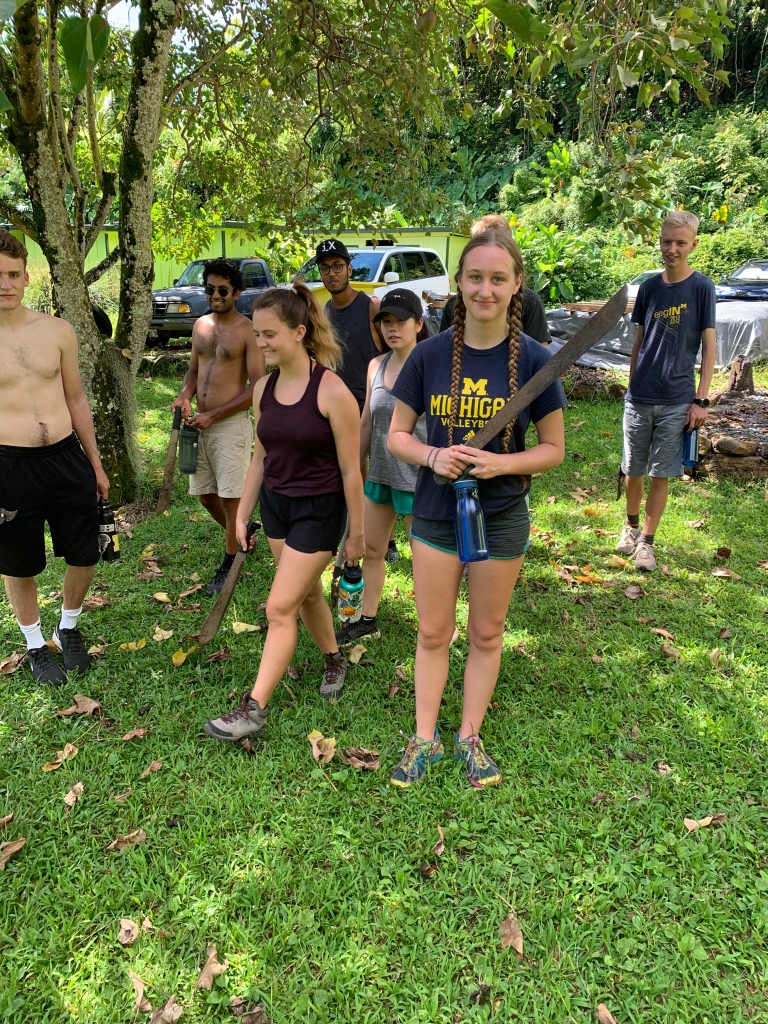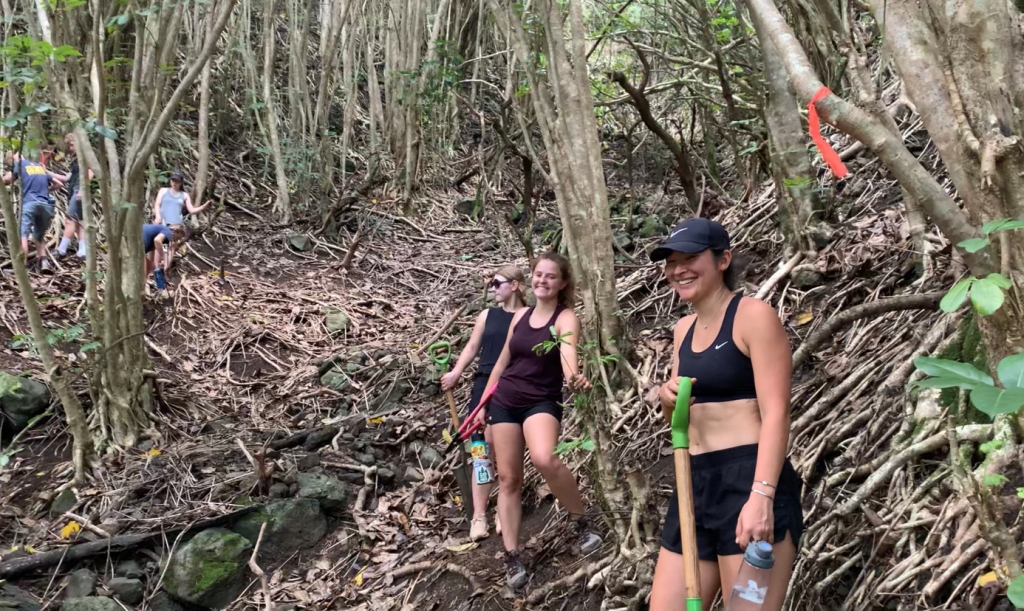Written by: Dean Golan
8/19/21
Our typical morning rituals have involved sunrise yoga and meditations, but we decided to take a break this morning since we had such an exhausting day and late night yesterday. After piling into our minivans and trekking across the island, we arrived at Papahana Kouala eager to work and learn more about Hawaiian heritage. Upon our arrival we joined the staff in their morning ritual, where they blow a conch shell in all 4 cardinal directions to greet the sun, mountains, and rivers, and start the day with good intentions. After the ritual we started our first task of the day, which was trail maintenance for a new trail on the mountain of ‘Ioleka’a. Armored with machetes and shovels, the group channeled their primal instincts and entered the jungle. The day was especially hot, and we worked tirelessly to bushwhack plants and clear out brush from the trail with our machetes. On our way through the jungle we encountered some red berries, which our guide Ka’iwi informed us were strawberry guava, and so we eagerly scarfed down every last berry we could find. At the top of the mountain we took a break from our machete’ing and Ka’Iwi told us a couple stories about the history and mythology of the mountain we were on. We also had a discussion about the harmful effects of invasive species to foreign ecosystems and the devastating impacts people can have on an ecosystem by making thoughtless decisions with no regard to the land. We really came to understand the importance of serving as a humble steward to the land, rather than only acting as a greedy consumer. Seeing the entire ahupua’a (slice of land between mountain and sea) of He’eia from above showed us the value in striving for balance and harmony in life. Prior to the unlawful colonization of Hawaii, tribes lived in harmony within each ahupua’a and provided sustenance from the ocean to the mountains in one society. Nobody took more than they needed from the land, and people traded with one another and worked to preserve and protect the land, having no other alternative since there was no reliance on importation of goods. These discussions provoked our line of thinking and introduced alternative perspectives that we will all take home after this trip and apply into our daily lives.
Later that afternoon, we finished our trail maintenance work and took a plunge in the ice pool we had been frequenting for the past 2 days, providing a much needed bath for our muddy, bug-bitten, and sweaty bodies. For lunch we ordered takeout from the Waipole Poi Factory, a restaurant that specializes in Poi (mashed taro). Eating poi after previously working in the taro Lo’i was a really cool experience that brought a sense of closure to our time on Papahana Kouala. Despite the poi having a strange gelatinous consistency and exceptionally bland taste, we held a deeper appreciation for the cultural significance of the plant and the the hard work required to create such a local delicatessen. After lunch, we helped roll some meaty logs out of the forest for a chicken coop, and then we hopped in the stream to collect fish to be ground up and used as fertilizer for the taro plants. The tasks we had performed for Papahana Kouala continued to reinforce the principles of living in harmony with the land and our surroundings, and working to minimize wasteful behavior and think resourcefully to achieve balance in the ecosystem. One interesting thing we learned in the mountains was the value of the tea leaf plant: every part of the plant is used for some purpose in Hawaiin culture – the roots used to make moonshine, the flower used to treat asthma, and the leaves to build hula dancing skirts. By thinking resourcefully and avoiding sheer consumerism we can strike a balance that will help to push the world towards giving more than receiving and can hopefully combat climate change. We ended the workday with a closing ceremony, where the workers sang a chant in Hawaiian to express thanks to the sun and resources of the land for providing us with sustenance and happiness.
After working the full day, Alexios and Joey were eager to bring their cheffing skills to Hawaii and so we bought grilling equipment and a mountain of food so we could feast on the beach right by our campsite. We grilled some meaty veggie burgers, ahi tuna, marinated chicken, and a bunch of veggies and pineapple to supplement our meal. We did some classic EGL bonding with soccer games on the beach, hot seat circles, assumptions, and star gazing to end the night. An all around incredible day packed with learning, activities, and bonding, we went to bed eager to continue our trip!












